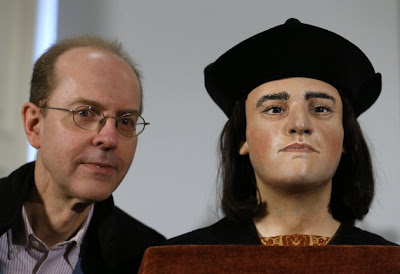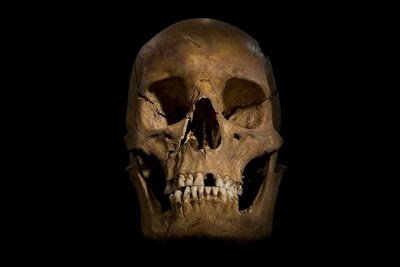King Richard III's Remains Found After 500 Years
With a large chin, a prominent slightly arched nose and delicate lips,
the "face" of England's King Richard III was unveiled on Feb. 5, a day
after researchers confirmed his remains had finally been found after 500
years.
A facial reconstruction of King
Richard III is displayed at a news conference in central London February
5, 2013. The reconstruction is based on a CT scan of human remains
found in a council car park in Leicester which are believed to belong to
the last of the Plantagenet monarchs of Britain who was killed at the
battle of Bosworth in 1485.
Michael Ibsen, a 17th generation
nephew of King Richard III, poses with a facial reconstruction of King
Richard III at a news conference in central London February 5, 2013. The
reconstruction is based on a CT scan of human remains found in a
council car park in Leicester which are believed to belong to the last
of the Plantagenet monarchs of Britain who was killed at the battle of
Bosworth in 1485.
Jo Appleby, a lecturer in Human Bioarchaeology, at University of
Leicester, School of Archaeology and Ancient History, who led the
exhumation of the remains found during a dig at a Leicester car park,
speaks at the university Monday Feb. 4, 2013. Tests have established
that a skeleton found , including this skull, are "beyond reasonable
doubt" the long lost remains of England's King Richard III, missing for
500 years.
The skull of Richard III is seen in this photograph provided by the
University of Leicester and received in London on February 4, 2013. A
skeleton with a cleaved skull and a curved spine entombed under a car
park is that of Richard III, scientific tests confirmed, solving a
500-year-old mystery about the final resting place of the last English
king to die in battle.
The front of Richard III's skull is seen in this photograph provided
by the University of Leicester and received in London on February 4,
2013. A skeleton with a cleaved skull and a curved spine entombed under a
car park is that of Richard III, scientific tests confirmed, solving a
500-year-old mystery about the final resting place of the last English
king to die in battle.
The skeleton of Richard III,
which was discovered at the Grey Friars excavation site in Leicester,
central England, is seen in this photograph provided by the University
of Leicester and received in London on February 4, 2013. A skeleton with
a cleaved skull and a curved spine entombed under a car park is that of
Richard III, scientific tests confirmed, solving a 500-year-old mystery
about the final resting place of the last English king to die in
battle.
Two vertebrae from the spine of
Richard III are seen in this photograph provided by the University of
Leicester and received in London on February 4, 2013. The vertebrae show
some abnormal features; the spinous processes of the vertebrae
(bottom), which should be straight, are twisted to one side and there
are signs of osteoarthritis in the joints between the vertebrae. A
skeleton with a cleaved skull and a curved spine entombed under a car
park is that of Richard III, scientific tests confirmed, solving a
500-year-old mystery about the final resting place of the last English
king to die in battle.
The spine of Richard III is seen in this photograph provided by the
University of Leicester and received in London on February 4, 2013. A
skeleton with a cleaved skull and a curved spine entombed under a car
park is that of Richard III, scientific tests confirmed, solving a
500-year-old mystery about the final resting place of the last English
king to die in battle.
Archaeologist Mathew Morris stands in the trench where he found
skeleton remains during an archaeological dig to find the remains of
King Richard III in Leicester, central England in this file photograph
dated September 12, 2012. Archaeologists will reveal next week whether a
skeleton with a cleaved skull and a curved spine entombed under a
municipal car park is that of Richard III, the last English king to die
in battle, more than five centuries ago. Photograph taken September 12,
2012.

University of Leicester archeologists are digging in the Leicester
City Council parking lot in search of the grave of King Richard III.

The skeleton of Richard III is seen in a trench at the Grey Friars
excavation site in Leicester, central England, in this picture provided
by the University of Leicester and received in London on February 4,
2013. A skeleton with a cleaved skull and a curved spine entombed under a
car park is that of Richard III, scientific tests confirmed, solving a
500-year-old mystery about the final resting place of the last English
king to die in battle.

Richard III died in battle during the War of the Roses. After his
death, he was buried at Greyfriars church in Leicester, but the location
was soon lost to history.

Inlaid floor tiles unearthed from the Greyfriars church site.


















